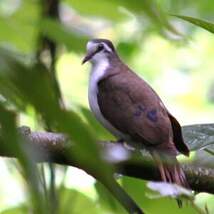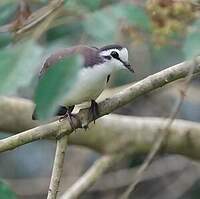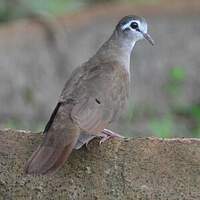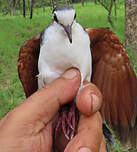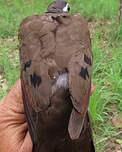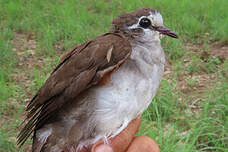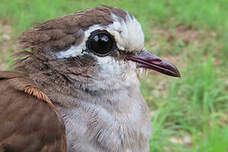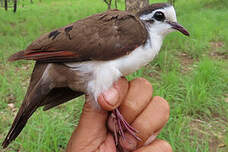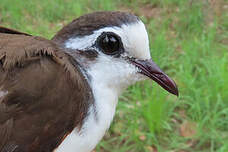Tambourine Dove
Turtur tympanistria - Tourtelette tambourette
Identification
Small sized, the Tambourine Dove appears to be two-toned at first glance, brown on top and white underneath. However, there is a sexual dimorphism, the only case in the genus Turtur. When perched, the male is darker than the female. The crown, sides of the neck and back are dark brown. Two small, round, black spots are visible on the wing covers and are slightly iridescent. The covers are brown-chocolate, the remiges and rectrices are mainly chestnut with light stripes on the edges. The forehead, back of the eyes, throat, chest, flanks and belly are all brightly white. The female is a bit more dull underneath. She retains white forehead like the male, but the throat, chest, flanks and belly are gray-blue. The middle of the chest can sometimes appear very light chamois. The spots that she has on the wings are much less iridescent than those of the male. In both sexes, the eyes are black, connected to the beak by a black line that is very visible even from a distance, the beak is red-carmine with a black or gray tip and the legs are dark red. The juvenile is similar to the female but still has many streaked reddish brown feathers.
Subspecific information monotypic species
Foreign names
- Tourtelette tambourette,
- Palomita tamborilera,
- rola-de-papo-branco,
- Tamburintaube,
- fehérhasú erdeigerle,
- Tamboerijnduif,
- Tortora tamburina,
- tambourinfläckduva,
- Tamburindue,
- bronzovka bubeník,
- hrdlička bubínková,
- Tamburindue,
- tamburiinikyyhky,
- Witborsduifie,
- tortoreta timbalera,
- turkaweczka białoczelna,
- Белогрудая лесная горлица,
- タンバリンバト,
- 白胸森鸠,
- tambourinfläckduva,
- 白胸森鳩,
Voice song and call
The Tambourine Dove gives a series of cooing sounds, up to 40 in a span of fifteen seconds. Its song starts with rather muffled cooing that becomes more rhythmic afterwards, ending in a longer duration. The Tambourine Dove's song does not vary between Africa and Comoros, however an in-depth analysis showed slight variations between the Comorian islands. In Mayotte, the call starts with 8 to 12 hesitant syllables followed by 22 to 24 rapid syllables. In Mohéli and Grande Comore, there would only be 7 to 11 syllables at the beginning of the song.
Habitat
Behaviour character trait
The Tambourine Dove can be seen alone or in pairs. Small groups of up to 8-10 individuals are extremely rare.
It appears that in July and August, numbers increase in Natal, but this has not yet been documented. It spends most of its time on the ground looking for food in primary or secondary forest, as well as on the edge and in small clearings. This is also where it is most visible, but only for a split second as it is very discreet and evasive and does not stay exposed for long. Furthermore, daytime movements are very limited.Flight
Dietfeeding habits
Reproduction nesting
The Tambourine Dove is monogamous and defends large territories (up to 2 to 3 hectares). The breeding season varies by geographical region.
In Sierra Leone, it extends from January to April. In East Africa, it can be very variable but two main periods are preferred: January to March and May to November. In Central Africa, it takes place all year round. From September to May in the Zimbabwe region and from October to March in South Africa. The nest is located at a low height. It is made up of a mixture of small twigs, often placed on a fork or a main branch. The male brings the materials to the female who arranges the nest. Usually two cream-colored eggs are laid in the nest and incubation lasts about two weeks, mainly by the female. The young are fed by regurgitation and by both sexes. They are flying at around 14 days. After leaving the nest, the young remain dependent on the parents for a week but do not leave the family group in the following days.Geographic range
The Tambourine Dove is primarily a sedentary and nesting species in Africa to the south of the Sahara Desert. The species is distributed from Senegal to Ethiopia, from Gabon to Kenya, then descends along the coasts of East and South-East Africa. It remains absent from the dry areas of South-West Africa. In the Madagascar region, it is restricted to the Comoros archipelago: Mayotte, Grande Comore, Moheli, but is poorly known on Anjouan. It is mainly concentrated on the drier coastal zones of these first three islands. It is an entirely absent species on Madagascar.
Threats - protection
Sources of information
- IOC World Bird List (v15.1), Gill, F and D Donsker (Eds). 2025-12-07.
- BirdLife International, BirdLife International
- Wikipedia (English version),
- Les Oiseaux de Mayotte, Clément Michel, Grissac Philippe, Rolland Robin
- Pigeons and Doves, David Gibbs, Eustace Barnes and John Cox
- The Birds of Africa Vol VIII : The Malagasy Region, Safford R. et Hawkins F.
Other sources of interest
 Specification sheet created on
25/07/2023 by Nathalie Santa Maria
Specification sheet created on
25/07/2023 by Nathalie Santa MariaTranslation by AI Oiseaux.net
© 1996-2025 Oiseaux.net
- Accipitriformes
- Aegotheliformes
- Anseriformes
- Apodiformes
- Apterygiformes
- Bucerotiformes
- Caprimulgiformes
- Cariamiformes
- Casuariiformes
- Charadriiformes
- Ciconiiformes
- Coliiformes
- Columbiformes
- Coraciiformes
- Cuculiformes
- Eurypygiformes
- Falconiformes
- Galliformes
- Gaviiformes
- Gruiformes
- Leptosomiformes
- Mesitornithiformes
- Musophagiformes
- Nyctibiiformes
- Opisthocomiformes
- Otidiformes
- Passeriformes
- Pelecaniformes
- Phaethontiformes
- Phoenicopteriformes
- Piciformes
- Podargiformes
- Podicipediformes
- Procellariiformes
- Psittaciformes
- Pterocliformes
- Rheiformes
- Sphenisciformes
- Steatornithiformes
- Strigiformes
- Struthioniformes
- Suliformes
- Tinamiformes
- Trogoniformes





